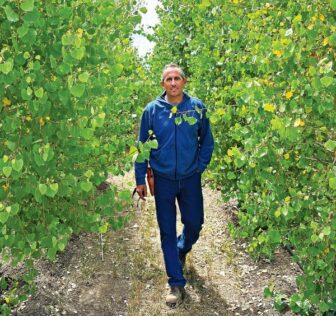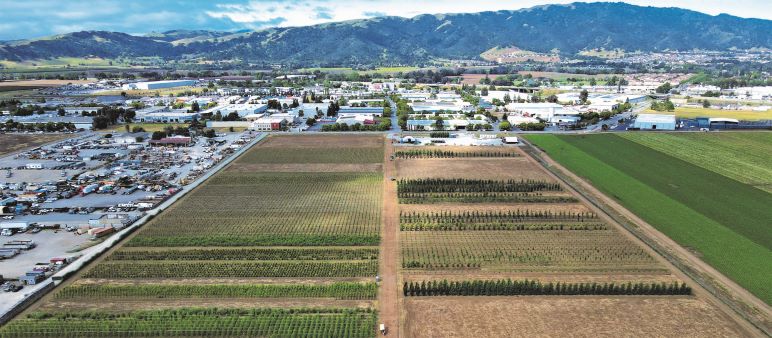Greg Bozzo, sitting behind the wheel of an all-terrain vehicle, traverses through a tree farm that has sprouted up next to an industrial area on Rossi Lane in Gilroy.
He points to rows of valley oaks, saying the trees were half their current size only a year ago. The native Californian trees love the dirt and weather here, and are growing at a pace that is often difficult to keep up with.
The 40-acre piece of land is owned by Google, the Silicon Valley tech giant that purchased the Gilroy property in 2019 with the goal of growing trees in an environmentally sound way for its future and current campuses.
But Google, in an era of remote work and a shifting economy, has lately reevaluated its real estate portfolio, shedding office spaces in the northern end of the county.

Greg Bozzo of GB Landscape Services walks through a row of young Fremont poplar trees growing at a farm owned by Google on Rossi Lane in Gilroy. Photo by Tarmo Hannula
As a result, the 15,000 trees growing in Gilroy—including coast live oak, alder, willow, California maple and more—won’t all end up at a Google project as originally intended.
Bozzo, the owner of Gilroy-based GB Landscape Services who is the operator of the farm, has now been tasked with selling many of the trees to the public, including contractors working on developments across the Bay Area and beyond. Before that can happen, though, Bozzo has applied with the state to make his business a nursery, which he anticipates will be finalized in the coming weeks.
“Google is still committed to the idea of growing trees in an environmentally sound way, but now we need these trees to have homes,” he said.
GB Landscape Services was awarded the operator job in December 2021, and began clearing the cheeseweed that had taken over the land, as it had not been farmed for many years. Planting the 15,000 trees occurred between March and fall 2022.
Every tree was planted in a fabric bag, Bozzo explained, allowing the roots to break through and continue their path through the soil, instead of being confined to a container that causes them to circle around themselves with nowhere to go.
With the bags, the trees not only establish a stronger root system, but they also produce a larger trunk. Utilizing drip irrigation, the farm also uses 70% less water than a conventional farm that grows trees in containers, according to Bozzo, and runoff is nonexistent.
But as the trees begin to branch out and tower over the land, their value will hit a peak depending on their size, as the bigger they are, the more difficult, and expensive, they are to transport.
The full-time staff of 10 not only mechanically pulls weeds from the rows—as no synthetic herbicides are allowed—but prune the trees daily to keep them at a reasonable size. Due to the speed the trees are growing, such a process is ongoing.
“That’s part of our challenge,” Bozzo said. “They’re growing so fast.”
One of Google’s goals with the project was to have the property involved with the Gilroy community, Bozzo said.
So, Bozzo came up with the idea of not only allowing the employees to grow their own vegetables, but also open a community garden.
The half-acre section that fronts the property on Rossi Lane features plots shared by 32 families, who are growing corn, tomatoes, Swiss chard and more. Google provides the water, through hand-held hoses and an underground drip system, and electricity, while GB Landscape Services provides the labor and materials. Local farmers and a Gilroy gardening group donated various equipment.
“It’s a cool little community out here,” Bozzo said, adding that the families all help each other with their gardens while sharing their crops. “That part has been really, really rewarding.”
On a recent evening, Jorge Mendoza and others were tending to their crops. He said he gets “great enjoyment” out of visiting the community garden.
“You meet people here and we share what comes out of the garden,” Mendoza said. “It is like a family: We come here and get to know each other and we help each other out. It is so relaxing to be out here in the evening as the sun goes down; it's peaceful and it's what our community needs.”
He praised the well-built garden, from the paths, irrigation and the beds.
“There are so many things growing here and people love it,” Mendoza said.
Tarmo Hannula contributed to this article.

